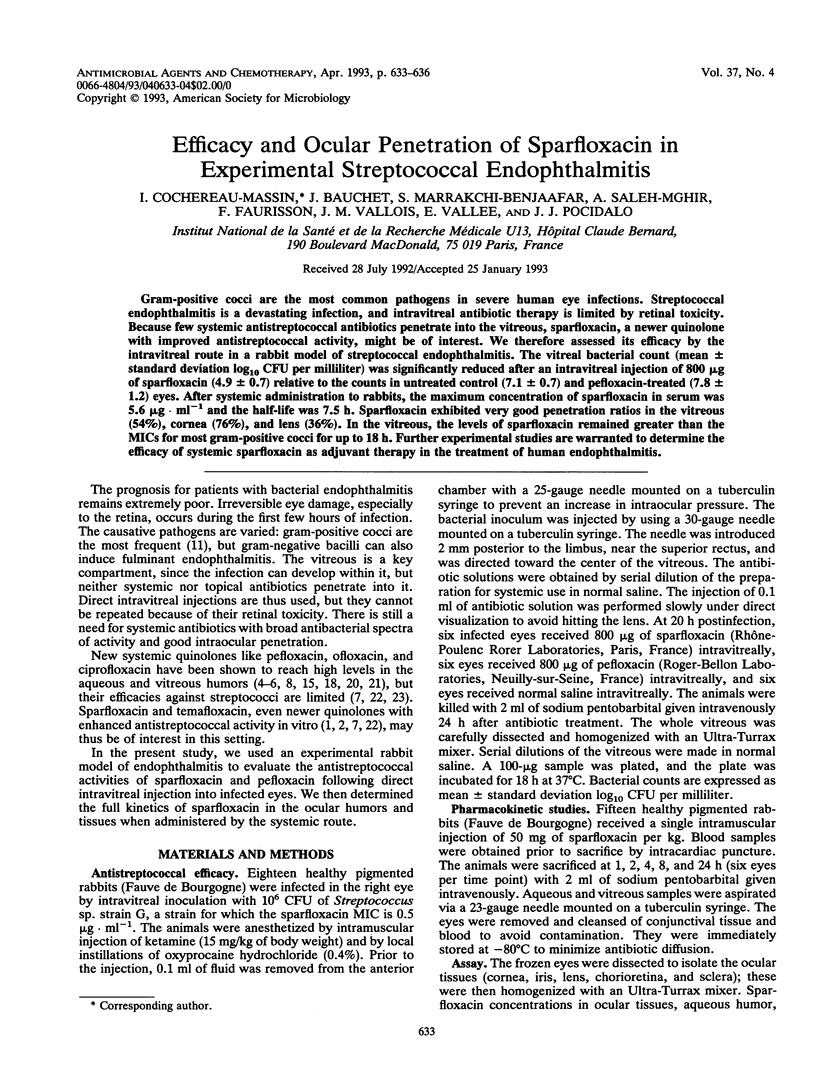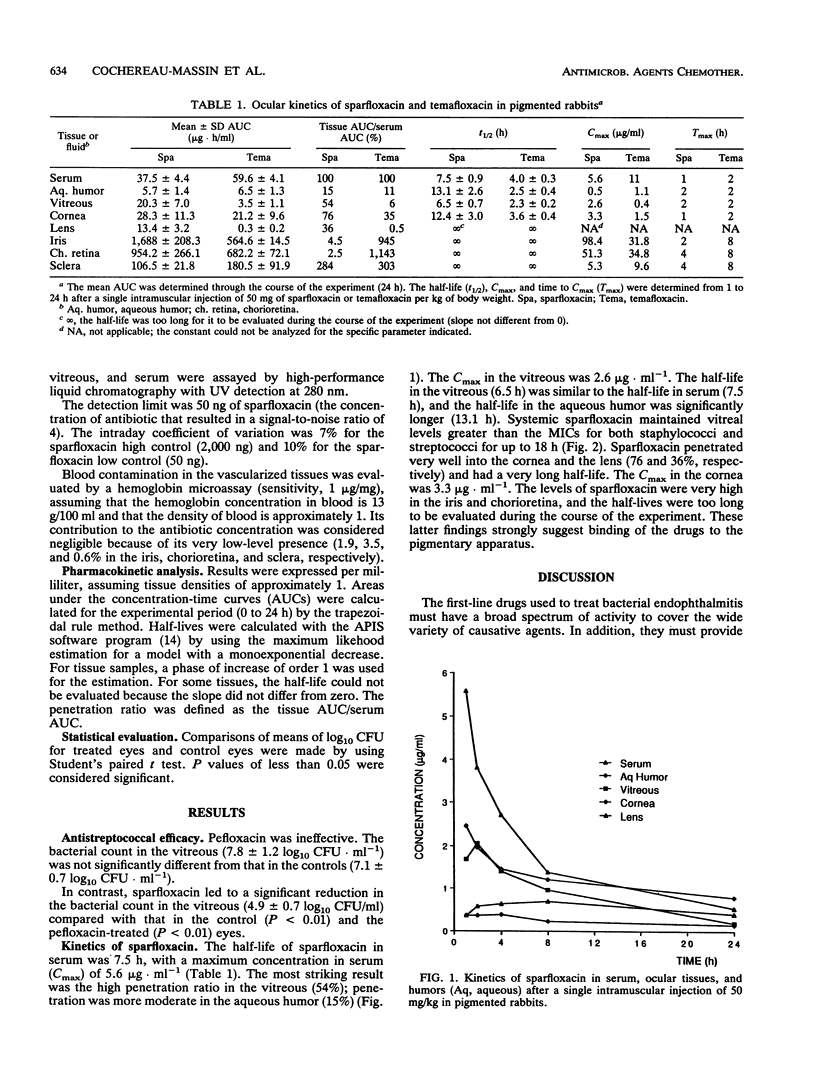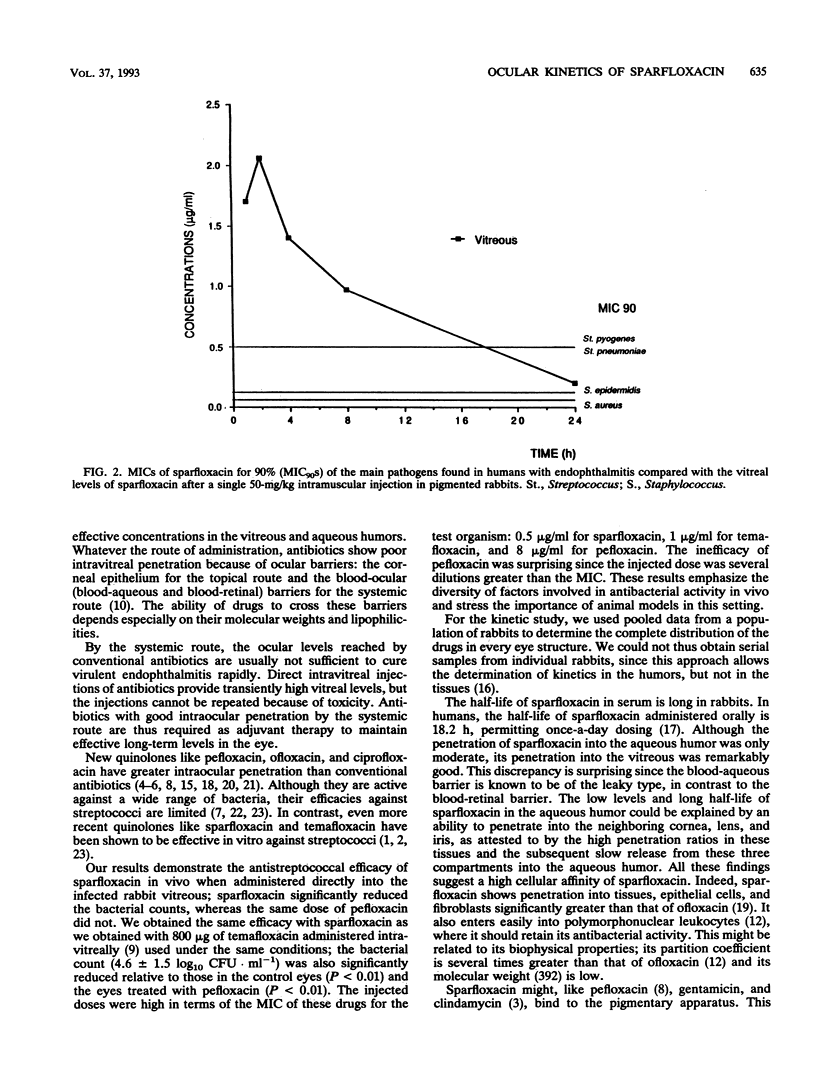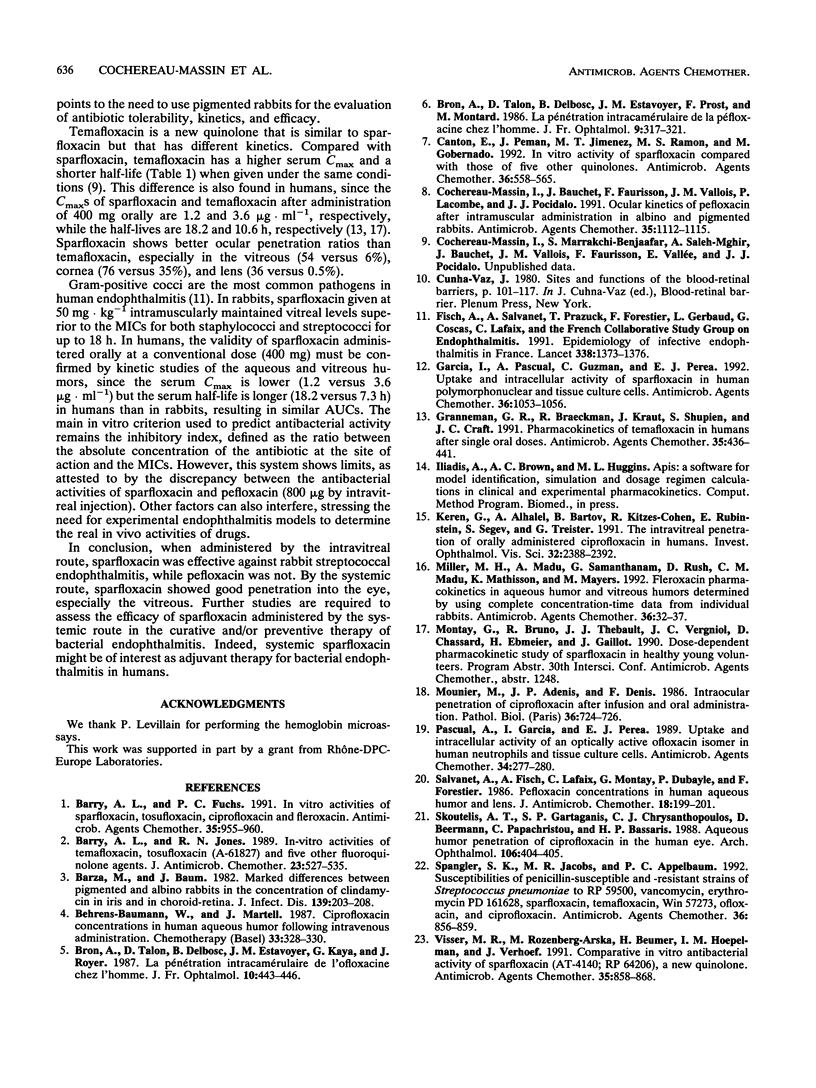Abstract
Gram-positive cocci are the most common pathogens in severe human eye infections. Streptococcal endophthalmitis is a devastating infection, and intravitreal antibiotic therapy is limited by retinal toxicity. Because few systemic antistreptococcal antibiotics penetrate into the vitreous, sparfloxacin, a newer quinolone with improved antistreptococcal activity, might be of interest. We therefore assessed its efficacy by the intravitreal route in a rabbit model of streptococcal endophthalmitis. The vitreal bacterial count (mean +/- standard deviation log10 CFU per milliliter) was significantly reduced after an intravitreal injection of 800 micrograms of sprafloxacin (4.9 +/- 0.7) relative to the counts in untreated control (7.1 +/- 0.7) and pefloxacin-treated (7.8 +/- 1.2) eyes. After systemic administration to rabbits, the maximum concentration of sparfloxacin in serum was 5.6 micrograms.ml-1 and the half-life was 7.5 h. Sparfloxacin exhibited very good penetration ratios in the vitreous (54%), cornea (76%), and lens (36%). In the vitreous, the levels of sparfloxacin remained greater than the MICs for most gram-positive cocci for up to 18 h. Further experimental studies are warranted to determine the efficacy of systemic sparfloxacin as adjuvant therapy in the treatment of human endophthalmitis.
Full text
PDF



Selected References
These references are in PubMed. This may not be the complete list of references from this article.
- Barry A. L., Fuchs P. C. In vitro activities of sparfloxacin, tosufloxacin, ciprofloxacin, and fleroxacin. Antimicrob Agents Chemother. 1991 May;35(5):955–960. doi: 10.1128/aac.35.5.955. [DOI] [PMC free article] [PubMed] [Google Scholar]
- Barry A. L., Jones R. N. In-vitro activities of temafloxacin, tosufloxacin (A-61827) and five other fluoroquinolone agents. J Antimicrob Chemother. 1989 Apr;23(4):527–535. doi: 10.1093/jac/23.4.527. [DOI] [PubMed] [Google Scholar]
- Barza M., Kane A., Baum J. Marked differences between pigmented and albino rabbits in the concentration of clindamycin in iris and choroid-retina. J Infect Dis. 1979 Feb;139(2):203–208. doi: 10.1093/infdis/139.2.203. [DOI] [PubMed] [Google Scholar]
- Behrens-Baumann W., Martell J. Ciprofloxacin concentrations in human aqueous humor following intravenous administration. Chemotherapy. 1987;33(5):328–330. doi: 10.1159/000238517. [DOI] [PubMed] [Google Scholar]
- Bron A., Talon D., Delbosc B., Estavoyer J. M., Kaya G., Royer J. La pénétration intracamérulaire de l'ofloxacine chez l'homme. J Fr Ophtalmol. 1987;10(6-7):443–446. [PubMed] [Google Scholar]
- Bron A., Talon D., Delbosc B., Estavoyer J. M., Prost F., Montard M. La pénétration intracamérulaire de la péfloxacine chez l'homme. J Fr Ophtalmol. 1986;9(4):317–321. [PubMed] [Google Scholar]
- Cantón E., Pemán J., Jimenez M. T., Ramón M. S., Gobernado M. In vitro activity of sparfloxacin compared with those of five other quinolones. Antimicrob Agents Chemother. 1992 Mar;36(3):558–565. doi: 10.1128/aac.36.3.558. [DOI] [PMC free article] [PubMed] [Google Scholar]
- Cochereau-Massin I., Bauchet J., Faurisson F., Vallois J. M., Lacombe P., Pocidalo J. J. Ocular kinetics of pefloxacin after intramuscular administration in albino and pigmented rabbits. Antimicrob Agents Chemother. 1991 Jun;35(6):1112–1115. doi: 10.1128/aac.35.6.1112. [DOI] [PMC free article] [PubMed] [Google Scholar]
- Fisch A., Salvanet A., Prazuck T., Forestier F., Gerbaud L., Coscas G., Lafaix C. Epidemiology of infective endophthalmitis in France. The French Collaborative Study Group on Endophthalmitis. Lancet. 1991 Nov 30;338(8779):1373–1376. [PubMed] [Google Scholar]
- García I., Pascual A., Guzman M. C., Perea E. J. Uptake and intracellular activity of sparfloxacin in human polymorphonuclear leukocytes and tissue culture cells. Antimicrob Agents Chemother. 1992 May;36(5):1053–1056. doi: 10.1128/aac.36.5.1053. [DOI] [PMC free article] [PubMed] [Google Scholar]
- Granneman G. R., Carpentier P., Morrison P. J., Pernet A. G. Pharmacokinetics of temafloxacin in humans after single oral doses. Antimicrob Agents Chemother. 1991 Mar;35(3):436–441. doi: 10.1128/aac.35.3.436. [DOI] [PMC free article] [PubMed] [Google Scholar]
- Keren G., Alhalel A., Bartov E., Kitzes-Cohen R., Rubinstein E., Segev S., Treister G. The intravitreal penetration of orally administered ciprofloxacin in humans. Invest Ophthalmol Vis Sci. 1991 Jul;32(8):2388–2392. [PubMed] [Google Scholar]
- Miller M. H., Madu A., Samathanam G., Rush D., Madu C. N., Mathisson K., Mayers M. Fleroxacin pharmacokinetics in aqueous and vitreous humors determined by using complete concentration-time data from individual rabbits. Antimicrob Agents Chemother. 1992 Jan;36(1):32–38. doi: 10.1128/aac.36.1.32. [DOI] [PMC free article] [PubMed] [Google Scholar]
- Mounier M., Adenis J. P., Denis F. Pénétration intraoculaire de la ciprofloxacine après perfusion et prise orale. Pathol Biol (Paris) 1988 Jun;36(5 Pt 2):724–727. [PubMed] [Google Scholar]
- Pascual A., Garcia I., Perea E. J. Uptake and intracellular activity of an optically active ofloxacin isomer in human neutrophils and tissue culture cells. Antimicrob Agents Chemother. 1990 Feb;34(2):277–280. doi: 10.1128/aac.34.2.277. [DOI] [PMC free article] [PubMed] [Google Scholar]
- Salvanet A., Fisch A., Lafaix C., Montay G., Dubayle P., Forestier F., Haroche G. Pefloxacin concentrations in human aqueous humour and lens. J Antimicrob Chemother. 1986 Aug;18(2):199–201. doi: 10.1093/jac/18.2.199. [DOI] [PubMed] [Google Scholar]
- Skoutelis A. T., Gartaganis S. P., Chrysanthopoulos C. J., Beermann D., Papachristou C., Bassaris H. P. Aqueous humor penetration of ciprofloxacin in the human eye. Arch Ophthalmol. 1988 Mar;106(3):404–405. doi: 10.1001/archopht.1988.01060130430035. [DOI] [PubMed] [Google Scholar]
- Spangler S. K., Jacobs M. R., Appelbaum P. C. Susceptibilities of penicillin-susceptible and -resistant strains of Streptococcus pneumoniae to RP 59500, vancomycin, erythromycin, PD 131628, sparfloxacin, temafloxacin, win 57273, ofloxacin, and ciprofloxacin. Antimicrob Agents Chemother. 1992 Apr;36(4):856–859. doi: 10.1128/aac.36.4.856. [DOI] [PMC free article] [PubMed] [Google Scholar]
- Visser M. R., Rozenberg-Arska M., Beumer H., Hoepelman I. M., Verhoef J. Comparative in vitro antibacterial activity of sparfloxacin (AT-4140; RP 64206), a new quinolone. Antimicrob Agents Chemother. 1991 May;35(5):858–868. doi: 10.1128/aac.35.5.858. [DOI] [PMC free article] [PubMed] [Google Scholar]


